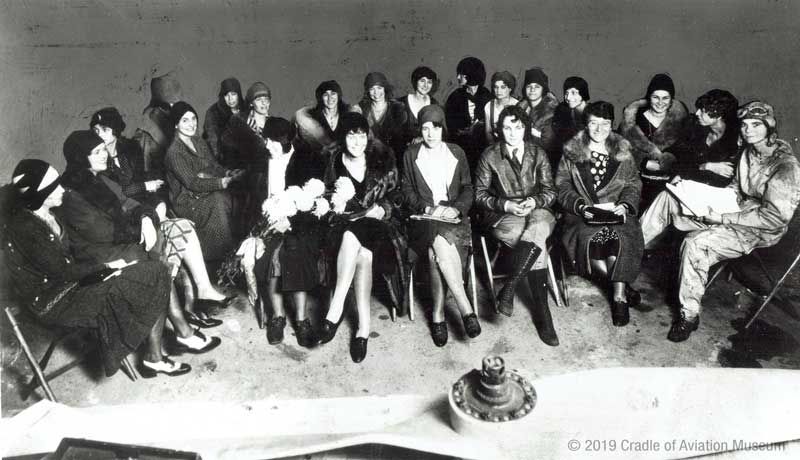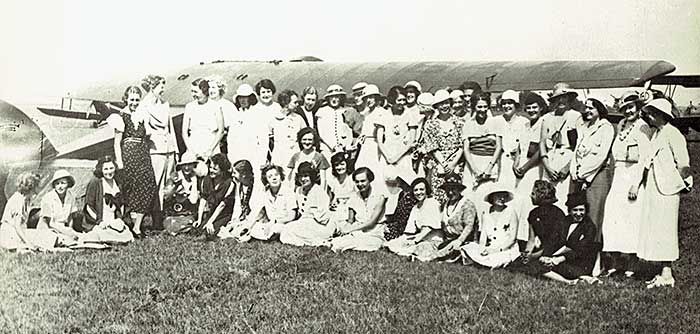The Song of the Ninety-Nines
By Julia Lauria-Blum (as first published in Metropolitan Airport News)

Elise Raymonde Deroche was born in 1882 in Paris, France. Having a fondness for sports as a child and then for motorcycles, automobiles and ballooning, she later became an actress, taking the stage name of Baroness Raymonde de Laroche. Ever the thrill seeker, de Laroche then pursued another lofty quest, that of flying an aeroplane.
In 1909, this was an especially lofty goal for a woman of her era and Raymonde appealed to her friend, French aviator and airplane builder, Charles Voisin to instruct her on how to fly. On March 8, 1910 Raymonde de Laroche became the first woman in the world awarded a pilot’s license issued by the Federation Aeronautique Internationale. Instrumental in the development and testing of early powered aircraft, de Laroche stated when asked about the dangers of flying, “It may be that I tempt the fates once too often. Who Knows? But it is to the air that I have dedicated myself, and I fly always without the slightest fear.” Ultimately fate did catch up with de Laroche in 1919 while flying in an experimental aircraft that went into a dive and crashed, killing both she and her co-pilot.
Even as the early years took a tremendous toll of aviation’s pioneers in crudely built, unwieldy flying machines, hundreds of intrepid aviators were to follow in de Laroche’s path and in the decades to come, women, like their male counterparts, were captivated by the desire to fly. Initially as observers, women became eager passengers and eventually pilots in their own right. In accomplishing the feat of flying, they broadened the traditional boundaries that had been set for their gender, attaining a sense of competency and achievement, contributing significantly to the progress and cause of aviation from its dawn to the present day.

Ninety-Nines Organization of Women Pilots, first meeting, 11-02-1929 Curtiss Field, Valley Stream, L.I. (Cradle of Aviation Museum)
By 1929, just two decades after de Laroche gained her pilot’s license, there were some 100 American women, and others internationally who were licensed to fly an airplane. That same year turned out to be a pivotal one for female pilots, when the first official Women’s Air Derby took place in conjunction with the National Air Races. The most prominent names of the time were in the lineup, including Amelia Earhart, Ruth Nichols, Louise Thaden, Phoebe Omlie, Pancho Barnes and fifteen other women who took off from the starting line at Santa Monica, California on August 18th with little more than a compass and a map on their laps.
Present at the start of the race was humorist Will Rogers who remarked that the start of the race looked like a “powder puff derby” and thereafter the Women’s Air Derby became more commonly known as such, the Powder Puff Derby. Six days and over 2,700 miles later from its start, fifteen of the twenty air racers crossed the finish line in Cleveland, Ohio with Louise Thaden claiming first place in her division of aircraft. But the race did not come without obstacles and tragedy when accomplished Alaskan bush pilot, Marvel Crosson experienced engine trouble and crashed to her death onto an Arizona desert on the second day of the race. Shocked and pained by the loss, and with the prospect of discontinuing the race due to a media storm of negative press, and the possibility of sabotage, the remaining air derby participants regrouped and rallied as one to continue the race, as they were certain Crosson would have wanted them to.

Early group of Ninety-Nines, Roosevelt Field, L.I. c.1930 (Cradle of Aviation Museum)
At the end of the Women’s Air Derby and the arrival of all the racers to Cleveland, the women felt a kinship that required a more official bond. As they gathered together at the field, pilot Phoebe Omlie was one of the derby racers who suggested the formation of an organization just for women pilots. Less than two months later an organizational letter dated October 9, 1929 was sent out to all licensed pilots in the United States and signed by Frances Harrell, Neva Paris, Margery Brown and Fay Gillis. Of the 117 licensed women pilots in the country, 86 responded and on November 2, 1929 twenty-six women gathered at Curtiss Field in Valley Stream, Long Island.
The women conducted their meeting in a hangar amongst the din of aircraft engines at the airfield and tea was served from a wheeled toolbox wagon. The criteria for eligibility into the organization was decided upon with membership open to any woman with a pilot’s license. The established purpose of the organization was for the mutual support and advancement of women pilots, “good fellowship, jobs and a central office and files on women in aviation”. In choosing a name for the organization attendee, Amelia Earhart proposed their name be taken from the sum total of the first 99 charter members who attended the meeting and who had expressed an interest in forming the organization which then was formally named “The Ninety-Nines”. In 1931, Amelia Earhart was elected the Ninety-Nines first president.

On November 2, 1979, the 50th anniversary dedication of a bronze marker commemorating the first meeting of the Ninety-Nines took place at the former site of Curtiss Field in Valley Stream. On the bronze, in bas relief, are depicted the twenty-six chartered members of the Ninety- Nines who posed together in solidarity for a photograph that captured their first meeting in 1929. Today, as the 90th anniversary of the first meeting approaches on November 2, 2019, membership in the Ninety-Nines International Organization of Women Pilots countries has grown world-wide, from 99 to over 5,100, hailing from 44 countries.
As the former site of the Ninety-Nines first meeting in Valley Stream is now occupied by a shopping mall, the bronze marker depicting that momentous meeting is no longer placed there but may now be seen at the Cradle of Aviation Museum in Garden City, where it is on loan courtesy of the Long Island-NY-NJ Chapters of the Ninety-Nines. Standing before it, if you listen carefully, you may just hear in the hallowed halls of Long Island’s aviation history repository, the voices of the Ninety-Nines, and of those daring women who came before them, singing, “In the air, everywhere, it’s the song of the Ninety-Nines. Wings in Flight, Day and Night with the Song of the Ninety-Nines, On the line, fliers fine, ships and spirit tuned in rhyme. Keep that formation over the nation with the song of the Ninety-Nines.“
